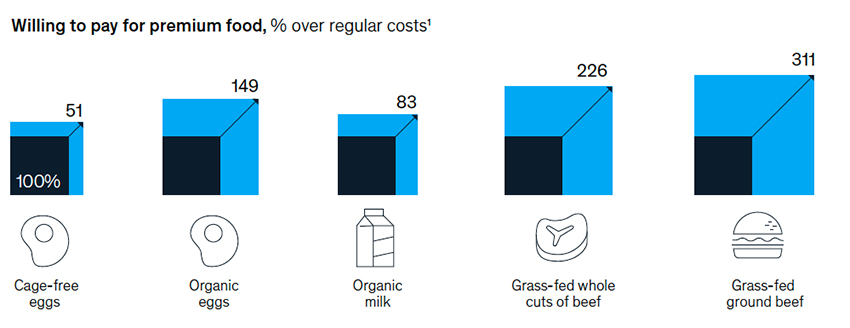Laboratory grown muscle cells from various animals are quickly becoming a commercial reality; they are already real food, at least in Singapore, the only country that has approved their use as a human food. As reported by McKinsey and Company, they anticipate that by 2030 0.5% of our meat consumption will be cultivated – and while that percentage is low, it represents 1.5 million tons of meat.
Raising cultivated meat
Cultivated meat is not really raised; it is produced in cell cultures, which, when scaled from the laboratory to industry, switches from Petri dishes to bioreactors. Bioreactors used to create new compounds or cells is a familiar technology, underlying fermentation, insulin production, and the development of biologics – to that degree, Big Pharma (Farma?) has the edge in expertise along with the brewers, vintners, and distillers.
The process is relatively straightforward; cells are taken from animals and grown in increasing concentrations in bioreactors (think stills), with a culture medium that includes nutrient and growth factors. Once the requisite cell density is reached, the culture media is removed by centrifugation “to achieve a low concentration of media in the harvest cells.” Those cells are then processed by themselves or with plant-based additives to create the appropriate three-dimensional texture.
To put that previously mentioned 1.5 million tons of meat in a different perspective, it will require enough bioreactors to fill 88 to 176 Olympic size swimming pools; pharma’s current capacity is ten pools
Speed bumps, hurdles, and disparities along the way
The first question might be, will there be a demand. For many vegetarians, who come to their dietary choices from an ethical point of view and certainly to vegans, they will have little interest. That leaves the vegetarians looking for a “healthful” alternative and the rest of us meat-eaters. That very sizable population already knows what a hamburger or a salmon fillet tastes like, setting a very high bar in creating a lab-based alternative.
The authors speculate that cultivated meat might open the market so that everyone can enjoy Wagyu beef or pigs raised on acorns. That is based on a simplistic notion that meat’s taste is solely a product of the cells rather than the diet that produced those cells. I would say that is a case that is yet to be proven. For the moment, we might expect a product that tastes like the foods we all can purchase, ground beef, chicken “nuggets,” and fish sticks.
Then there are the additives. That cultured meat approved in Singapore is 70% chicken and 30% plant protein and other products that create the meat’s texture. An Israeli startup adds cultivated fat and plant protein to get the texture of their “meat” correct. Impossible Burger has been criticized for its content of salt and fats. We haven’t even considered what concerns trace amounts of the culture medium, which itself contains growth-enhancing compounds, may raise – though we know that concerns will arise. Cultured meat is new food technology, and we already have fears, legitimate or not, around GMO’s which have been around for decades.
Cultivated meat will exacerbate disparities already present. There is their cost, which will initially be high until brought down by the economies of scale. But as the graphic shows, the wealthy or well-off already will spend for a more healthful (?) or more ethically raised food.

If these products gain market share, conventional sources of meat might contract, causing their prices to rise – it is not economically inevitable that cultivated meat will bring more of these proteins to those already eating “low on the hog.” (By the way, there are some delicious meals to be found there.) Those same “contractions” will also result in changes in the job market. While it seems the labor necessary for conventional and culture meat is the same, the skill set is quite different – we will need more engineers, fewer wranglers.
Cultured meat doesn’t graze or feed; it is bathed in nutrients locked within controlled environments. While provenance is essential in branding, is there a value in your meal coming from a specific region when the same cells, nutrients, and processes are being used right in your neighborhood? Cultivated meat is to conventional meat as remote work is to the office. Meat production can occur anywhere and is no longer limited by geography and climate. That will have harmful economic repercussions to areas already being farmed and opportunities to “raise” meat anywhere. Reduction in transportation costs will add to the anticipated ecologic benefits.
Finally, regulators will be called upon to determine safety and labeling. New industries will arise to produce the media necessary to grow cells at scale. Factories and the equipment they contain will have to be designed and built. There will be a moment for significant innovation, all stemming from a desire to continue to feed a hungry planet.
Sources: Cultivated meat: Out of the lab, into the frying pan McKinsey and Company




